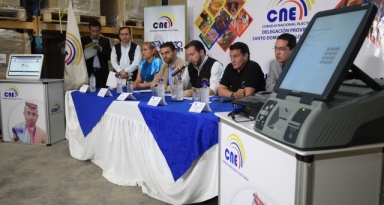
The machine that will be used by voters at Santo Domingo de los Tsáchilas is a Smartmatic-designed model. Photo: CNE
At the core of every automated voting process is the voting machine, and Ecuador has set out to try three different machines with different technologies, in order to choose which direction to follow in modernizing their elections. On February 24th (during the country’s local elections) close to 1 million voters will not only select their regional authorities, but in a way they will also choose their voting system’s future.
Ecuador’s strategy is to have its electoral technology scrutinized by both technicians and citizens; with this intend the country has designed a binding pilot e-voting test in the Azuay and Santo Domingo de las Tscáchilas departments, and an experimental one Quito’s sector of La Morita. Three voting machines will be employed, with characteristics that appear to be similar, but whose software will make a difference as the upcoming February elections will show.
The machines Azuay will use
In this area, Ecuador chose to try out the e-voting model designed by Magic Software Argentina (MSA), which is in use in the Argentine province of Salta. It includes an electronic ballot box and a smart ballot that must be inserted in the machine; doing so enables the user to make his/her choice by means of a touch screen. The votes are stored in a chip for a later count. The equipment lets the user cast blank and null votes, and produces a printed voting voucher.
The software generates opening and closing protocols, and vote count certificates for the election, but it doesn’t include automated tallying; the smart ballots must be inserted and read by a verification device embedded in the voting machine. This in required for the system to print and save a tally sheet, which is later sent electronically to a tallying centre.
The machines Santo Domingo de los Tsáchilas will use
The e-voting system this region will try out is based on the technology being used in Venezuela for the past 10 years, supplied by Smartmatic. The voters select their candidate through a touch screen which requires user confirmation before the vote is finalized. After the vote has been cast, the machine prints a paper receipt that shows the voter’s selection.
The software lets the voting machines store, count, tally and send the results in a safe, fully automated way. A characteristic of the system is that the process and the equipment in their entirety can be audited before, during and after the elections by technicians, citizens or institutions. The system contemplates several security measures, such as the redundant storage of the vote in several media and the safeguard of the voter’s identity through a randomized storage procedure. Users can check the printed vouchers against the results of the automated count.
The machines La Morita will use
Russian technology will be used in an experimental capacity in this section of the country’s capital, Quito. These machines are activated by means of a security card with a barcode. Their touch screen displays the voting options, and after the voter makes his/her selection (which includes null and blank votes), the vote is stored and ready to be transmitted.
